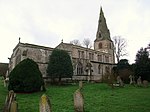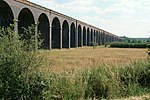RAF Spanhoe
1960 disasters in the United KingdomAirfields of the IX Troop Carrier Command in the United KingdomMilitary units and formations established in 1943Royal Air Force stations in NorthamptonshireUse British English from January 2014

Royal Air Force Spanhoe or more simply RAF Spanhoe (also known as Harringworth or Wakerley) is a former Royal Air Force station near Uppingham in Northamptonshire, England. The airfield is located approximately 4 miles (6.4 km) east of Uppingham; about 80 miles (130 km) north-northwest of London Opened in 1943, it was used by both the Royal Air Force and United States Army Air Forces. During the war it was used primarily as a transport airfield. After the war it was closed in late 1945. Today, much of the airfield has been returned to agriculture, however one runway remains and the airfield is currently active and houses various privately owned light aircraft.
Excerpt from the Wikipedia article RAF Spanhoe (License: CC BY-SA 3.0, Authors, Images).RAF Spanhoe
Wakerley Road,
Geographical coordinates (GPS) Address Nearby Places Show on map
Geographical coordinates (GPS)
| Latitude | Longitude |
|---|---|
| N 52.562777777778 ° | E -0.62222222222222 ° |
Address
Spanhoe
Wakerley Road
NN17 3AA , Harringworth
England, United Kingdom
Open on Google Maps










